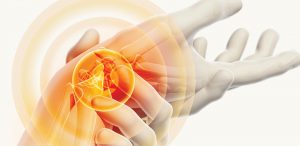Over the years, Oakville Chiropractor Dr. Brian Huggins and Dr. Tiffany Huggins have had several patients come into the office who have asked themselves the following questions:
- Are you experiencing numbness or pins and needles in your thumb or fingers?
- Do you feel intermittent pain in your wrist or hand?
- Does your grip seem to have become clumsy or weak?
If this sounds like you…read on!
Carpal Tunnel Syndrome
 It’s no secret that 2020 has been a year of changes. Millions of Canadians found themselves transplanted from their school and workplace environments, to conducting business as (un)usual from their own homes. Last month, our blog addressed the need to establish an ergonomically sound workspace to prevent the aches, pains, and strains that come along with improper equipment and technique (think: desk, chair, computer—sitting!).
It’s no secret that 2020 has been a year of changes. Millions of Canadians found themselves transplanted from their school and workplace environments, to conducting business as (un)usual from their own homes. Last month, our blog addressed the need to establish an ergonomically sound workspace to prevent the aches, pains, and strains that come along with improper equipment and technique (think: desk, chair, computer—sitting!).
This month, we have had a number of patients express that while they are at home, they actually tend to do more work than usual as their workspace is conveniently located a 10 step walk from bed. Longer hours, later nights, and more screen time are causing an influx in headaches, muscular tension and in computer users—carpal tunnel irritation.
What is the Carpal Tunnel?
The carpal tunnel is a small passageway comprised of the carpal bones and the transverse carpal ligament on the palmar side of your hand. Within the tunnel reside tendons that allow your fingers and thumb to bend towards the palm of your hand, and the median nerve that supplies sensation (to the thumb, index, long, and half of ring finger) and control to some of the hand’s flexor muscles. If the median nerve is subject to any compression, you may experience hand and wrist pain and paresthesia (numbness and tingling) in the thumb and subsequent two and a half fingers. Other symptoms may include weakness, stiffness and ‘clumsiness’ of fine motor skills. This condition is known as Carpal Tunnel Syndrome (CTS), or Median Nerve Compression at the wrist.
Who is at risk of Carpal Tunnel Syndrome?
CTS is statistically seen more commonly in females, those between the ages of 40 and 60, and with coinciding risk factors such as systemic changes (obesity, pregnancy, diabetes), certain metabolic diseases, inflammatory conditions, and history of trauma to the area. Topically, it is also a product of ergonomic stress and overuse which is an occupational hazard to many including athletes, doctors, trades, musicians, and you guessed it—those spending the majority of their day working on a computer. Its onset can arise after sustained posture (reading, driving, sleeping, etc.), repetitive tasks, or seemingly out of nowhere should there be an underlying concern.
How can you manage CTS?
- The simplest answer to this question is to cease activity causing irritation—but that is not always an option. So, here are some tips to help minimize the stress and strain.
Take a break! When completing any tasks that cause symptoms to flare up, make sure to include breaks that allow the hands to rest. It is beneficial to alternate activities, as different tasks require different skills (motor vs. mental), tools, and muscles. Try creating a system where you rotate through different stations or activities to complete your daily tasks. - Lighten up! It has been proven that using less force and a more relaxed grip can help reduce symptoms felt with CTS. Work smarter, not harder.
- Check your posture! Attempt to maintain a neutral spine, relaxed muscles, and follow the protocols outlined in our ergonomic blog found here. This includes watching that your wrists remain in a neutral position avoiding too much extension or flexion.
- Adjust your workspace! This means using a mouse and keyboard that allow your arms and wrists to remain at the proper height, without causing strain and discomfort. Think about using a mousepad that allows for extra wrist support to keep your wrists neutral.
- Shake and stretch! An important part of any athlete’s job is to warm up before taking to the ice/court/field. As an athlete of industry, you need to stretch and warm up as well. Along with taking breaks from sitting at least every hour, you should incorporate some neck, back, arm and hand stretches into your routine to prevent exacerbating symptoms. This can be as simple as taking 30 seconds to stop what you’re doing and shake your hands out to restore blood flow, perform some range of motion stretches to reduce stiffness and improve grip. Here is a list of some exercises to review—to see if they are right for you, come on in and see your friendly neighbourhood Chiropractor!
How can we help?
If you are uncertain that what you are experiencing is Carpal Tunnel Syndrome, come on in and let us assess you. We will conduct an in-depth history, assess range of motion, and complete orthopedic testing to see what’s going on. If you are suffering from mild to moderate CTS, and conservative management is right for you—we can offer chiropractic care including adjustments, soft tissue work, and home care including ergonomic advice and exercise programs. We look forward to meeting you here at Oakville Chiropractic Centre, until then—Have a safe and Happy Thanksgiving.
Sources:
• Carpal Tunnel Syndrome (Mayo Clinic)
• WebMD (Carpal Tunnel Exercises)




Greetings,
Thank you for sharing your blog.
https://www.renuhealthnow.com/
Thank You.